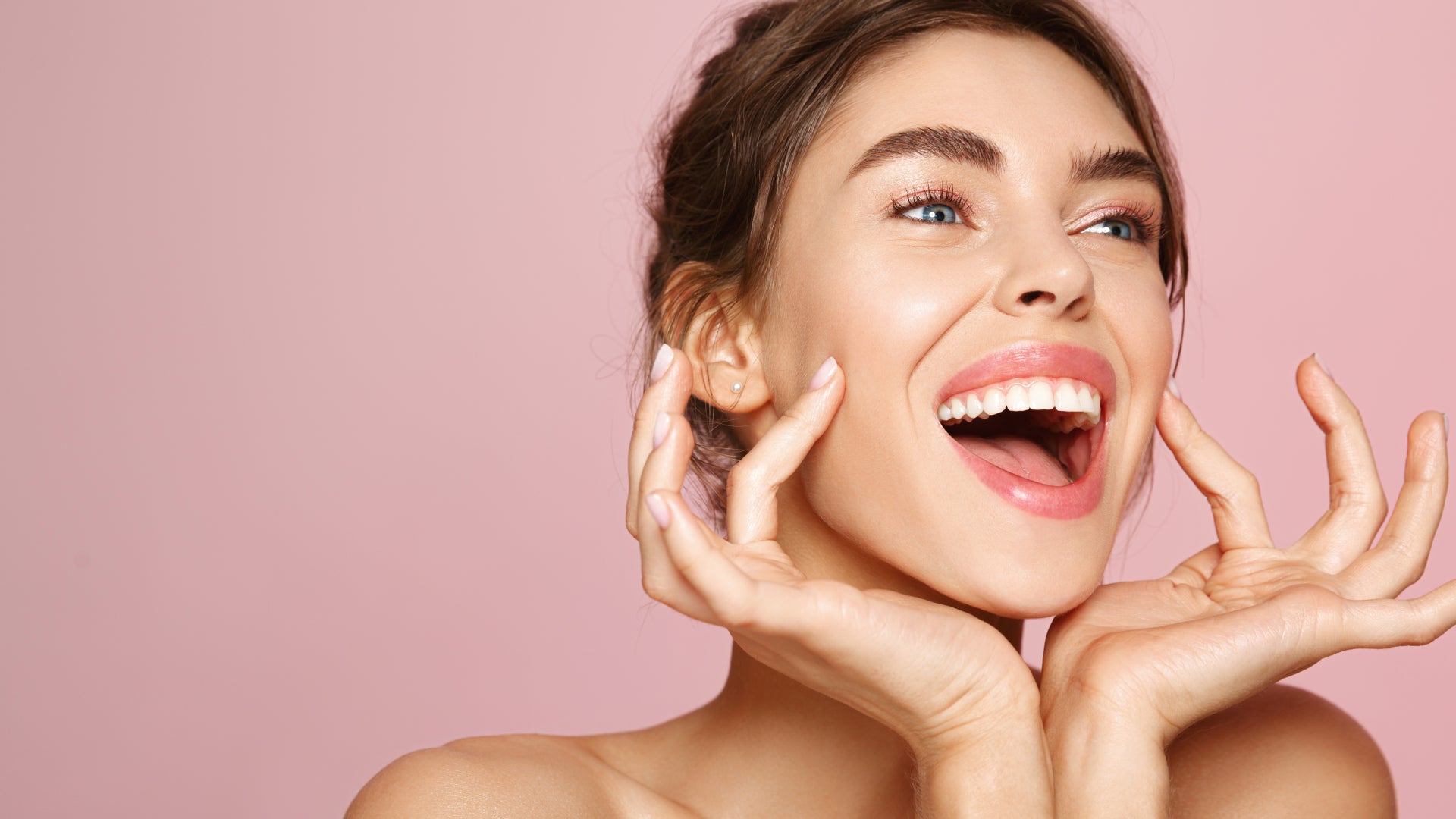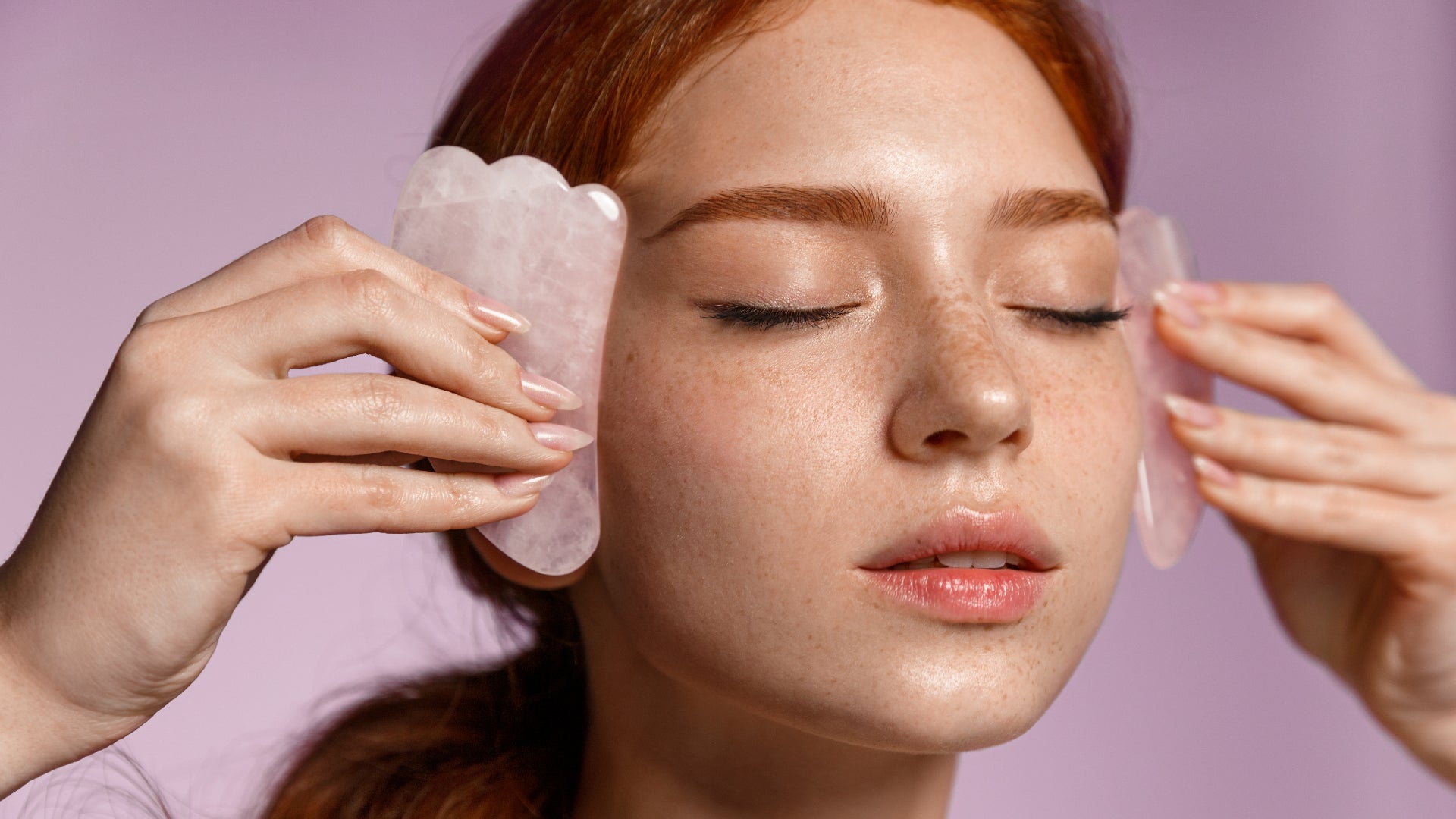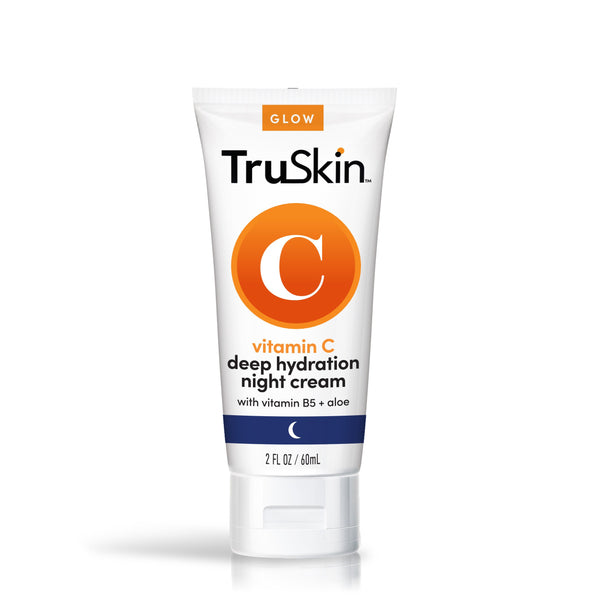
True Radical Honesty From Our Community
What To Do If You Hate Those Fine Lines Around Your Lips
Read MoreAdvice for all of your skin care needs
- all articles
- Acne
- Anti-Aging
- Collagen
- Combination Skin
- Company Announcements
- dry skin
- Exfoliation
- Eye Care
- Facial Redness
- Grooming
- Holidays
- Hyaluronic Acid
- Niacinamide
- Oily Skin
- Retinol
- Sensitive Skin
- Skincare
- Skincare Guide
- Skincare ingredients
- Skincare Routine
- Skincare Tips
- Sun Protection
- Toner
- Vegan Skincare
- Vitamin C
- view all
- Acne
- Anti-Aging
- Collagen
- Combination Skin
- Company Announcements
- dry skin
- Exfoliation
- Eye Care
- Facial Redness
- Grooming
- Holidays
- Hyaluronic Acid
- Niacinamide
- Oily Skin
- Retinol
- Sensitive Skin
- Skincare
- Skincare Guide
- Skincare ingredients
- Skincare Routine
- Skincare Tips
- Sun Protection
- Toner
- Vegan Skincare
- Vitamin C
-
Skin barrier protection is on everyone's lips right now. Why? Because this uppermost layer of your skin is a real workhorse – and it needs looking after if you want it to function properly. Here’s how…
Like many skincare brands, beauty blogs and glossy magazines, we often talk about the skin barrier. It's super important for the health of your skin. Which means it’s also super important for how your skin looks and feels on a daily basis.
But what is this elusive skin barrier? And why does it play such a vital role? Well, your skin’s barrier is basically its uppermost layer – the very top of your epidermis that’s made up of around 20 layers of cells and known in the beauty biz as the stratum corneum. This top brick wall-like layer arguably works harder than the rest of your skin put together because it acts like a security guard to protect your skin and your body from the outside world, preventing moisture from getting out and external irritants from getting in.
Of course, the aging process weakens your skin’s barrier as it naturally loses vital moisture, ceramides and cholesterol over time. Which is a bummer. And if you suffer with sensitive skin? Well, that's got a lot to do with having a thin or compromised barrier that’s unable to effectively keep pesky irritants like pollution, toxins, UV radiation and harsh chemicals at bay. These environmental stressors not only cause things like irritation, dryness, dehydration and redness for your skin, but they simultaneously keep chipping away at your skin’s barrier function, weakening it and making it even more prone to damage.
The basic premise is this: you must keep your skin barrier thick and resilient if you're serious about achieving and maintaining healthy, strong skin. An efficient, hardworking barrier will make your skin look far better than one that's not doing so well – think radiant, smooth, even... you know the drill.
So, want more intel on how to protect your skin’s all-important barrier? Read on for our five golden rules…
Rule #1: Pare Back Your Skincare Routine
Gosh, it’s tempting to lavish your skin with every vitamin, acid and goodness knows what other skin-loving ingredients you can get your hands on. And while complicated skincare routines might sound awesome in theory, too much of a good thing can reap disastrous results – especially where your skin’s barrier is concerned.
The key to a solid barrier-strengthening regimen is to keep it simple, yet effective. Easier said than done? Actually, no. Just avoid overloading your skin with tons of serums, essences, oils and potions containing active ingredients that could work against each other and irritate your skin. It’s as simple as that, really. Stick to a basic cleansing, toning and moisturizing routine, and add in just one treatment product, two at the absolute max – one for use in the morning and one for nighttime.
Our favorite serum for nourishing barrier function is Niacinamide Serum. Niacinamide has been shown to help boost ceramide production and is one of the best antioxidants for sensitive skin. Apply it before moisturizer for fabulous results.
Rule #2: Up Your Moisturizing Game
Moisturizers are key for hydrating the top layers of your skin and preventing transepidermal water loss (TEWL). And as you know, moisturizing is an important step in any skincare routine – whether your skin is oily and prone to breakouts, dry and itchy, or somewhere in between.
When it comes to skin barrier protection, the key is to find an effective moisturizer that’s packed with reparative ingredients like glycerin, hyaluronic acid, ceramides and botanical oils rich in essential fatty acids. We love Vitamin C Brightening Moisturizer.
Extreme dryness can seriously damage your skin’s barrier, leaving it vulnerable to external aggressors like pollution, UV radiation and the like, so if your barrier function has gotten out of whack and you’re experiencing a lot of dryness and abnormal sensitivities, moisturizer alone might not be enough. This is where a barrier cream may be needed. Barrier creams not only hydrate the skin and prevent dryness, but they also provide a kind of protective seal over your skin to repair damage, allowing your barrier to heal itself and therefore do its job better.
Rule #3: Press ‘Go’ On The Ultimate Protection Plan
Supercharged moisturizing is all well and good for building up your barrier function and healing your skin, but you also want to prevent further damage, right? Right. Well, on top of applying a broad-spectrum sunscreen every day, another great way to do this is to incorporate a topical antioxidant into your daily routine.
Antioxidants are the bee’s knees at neutralizing cellular damage caused by environmentally-induced free radicals. This means they’re a must if you want to look after your valuable collagen and elastin supplies. And, btw, you absolutely do want to look after collagen and elastin because they’re crucial for the integrity of your skin’s barrier – and your skin’s health, in general.
But as we mentioned, don’t overcomplicate your routine by bombarding your skin with too many antioxidant treatments. Find one you love for the morning (vitamin C is awesome!) and apply another before bed. Our Retinol Serum is a fantastic overnight treatment boasting antioxidants known to boost cellular turnover for stronger, brighter skin. Retinol can be potent, however, so always patch test it first and introduce it slowly into your routine to make sure you don’t compromise your skin’s protective barrier.
Rule #4: Try Not To Stress The Small Stuff
Stress is an ugly beast when it comes to your skin’s barrier. Not only has it been proven to deplete your skin’s production of healthy oils and valuable moisture, but stress also alters your skin’s pH level, produces unnecessary free radicals and triggers various hormones (hi there, cortisol), which can result in inflammatory reactions and all sorts of consequences like itching, redness and flaking skin. Stress has also been directly linked to chronic skin conditions including rosacea, psoriasis, acne and eczema. All of which are barrier issues. Sigh.
Managing stress isn't simple and unfortunately, there’s no solution that fits all. You could be totally into meditation or you might hate the thought of it. But try to think of something that relaxes you and do this for a good amount of time, every day. Perhaps it's reading a book, deep breathing, or going out for a walk. Even just watching your favorite show. Whatever your jam, find time to regularly do it. Honestly, this is the best place to start. And your skin will thank you for it.
Rule #5: Say A Big NO To Harsh Skincare Ingredients
We believe some ingredients have no place on your skin. Cleansing detergents like sodium laureth sulfate (SLS) and sodium lauryl ether sulfate (SLES), for example, alter your skin’s pH and strip your barrier of essential oils. Yes, they’re fabulous at getting rid of built-up dirt and debris, but tbh, they’re almost TOO good, so they end up leaving your skin’s barrier fragile and weak. The good news is we don’t include such nasties in our face washes, so you know you're getting good and clean with Vitamin C Brightening Cleanser or Charcoal Clarifying Cleanser.
While we’re on the subject of too much of a good thing, you might want to avoid synthetic fragrance in your skincare (which can seriously irritate sensitive skin) and try cutting back on physical exfoliation with things like cleansing brushes, mitts and abrasive scrubs. These can also upset your skin’s barrier if not used with care.
Of course, we can’t leave before finally mentioning a few other lifestyle habits that can do a real number on your skin’s barrier. Smoking, cruddy sleep and a poor diet are just a few and we’re sure you can think of many others – one of which starts with an ‘a’ and ends with an ‘l’.
The simple answer to this whole skin barrier protection game? Be nice to both your body and your skin. That is all.
Why Everyone’s Talking About Skin Barrier Protection
read more -
Can you really eat your way to healthier, glowy skin? We truly believe that if you combine a great diet with spot-on skincare, then yes, you totally can.
As a skincare company, awesome products that deliver quality, value and results are everything. But we also know that a great complexion doesn’t solely come from a fabulous skincare routine. Yes, gentle cleansing is vital. And of course, daily moisturizing and protecting your skin from that great big ball of fire in the sky are just as important. Duh! However, to truly max out your complexion and make sure you enjoy your best skin 24/7, you must also think about the food that goes into your body.
Now we would never (not even for one minute) suggest you cut out all the fun things from your diet – just try to take away our cupcakes and pinot, we dare you! – but moderation is key. And as long as you balance the slightly less nutritious stuff with plenty of skin-loving food and drink, your skin won't punish you for treating yourself every now and again.
Read on for ten essential nutrients to help your skin get its glow on…
1. Beta Carotene
Beta-carotene belongs to the carotenoid family and once ingested, gets converted by your body into vitamin A. So why's this good for your skin? Well, vitamin A is a fabulous antioxidant that protects your skin from environmental damage, thus helping push back the signs of premature aging for as long as possible. It also accelerates cellular turnover, boosts your skin’s natural protection from UV damage and helps give you a gorgeous glow.
Find It In: Any yellow-orange fruits and veggies, plus leafy greens.
Skincare Partner: Retinol Serum. Because retinol is the topical form of vitamin A, after all.
2. Omega-3 Fatty Acids
Unlike saturated and trans fats, omega-3s are the good guys because they help regulate sebum production, improve the fatty acid composition in your skin and strengthen your barrier function to reduce irritation, dryness and dehydration. Omega-3s have also been shown to help reduce breakouts and soothe skin concerns like eczema and psoriasis. It’s a must for your daily diet, no matter your skin type.
Find Them In: Fish oils, oily fish such as wild salmon and mackerel, flax seeds and chia.
Skincare Partner: Vitamin C Deep Hydration Night Cream, our richest moisturizer and the perfect way to relieve dryness and dehydration.
3. Flavonoids
Flavonoids are a type of polyphenol found in almost all fruits and vegetables. Just like carotenoids, flavonoids are responsible for their bright color – but they’re so much more than a pretty face. With powerful antioxidant properties, flavonoids are a great way to help protect your skin from oxidative stress and improve its strength and suppleness by reducing DNA and collagen destruction.
Find Them In: Green tea, red wine (hallelujah!), kale, strawberries and citrus fruits.
Skincare Partner: Retinol Moisturizer, which contains organic green tea.
4. Vitamin C
This antioxidant essential not only deals with the pesky free radicals that form in your skin after exposure to things like UV radiation and pollution, but vitamin C also encourages collagen and elastin production for stronger, younger-looking skin. Furthermore, studies show that vitamin C boosts the efficacy of your sunscreen AND balances melanin production for a brighter, healthier glow. Everything but the kitchen sink springs to mind, right?
Find It In: Kiwis, berries, citrus fruits, broccoli and red peppers.
Skincare Partner: Vitamin C Serum – our award-winning bestseller that's packed with vitamin C. Enough said.
5. Vitamin E
Often known as the moisturizing, healing vitamin in the world of skincare, vitamin E is equally as important in your diet as it is in your face cream. Just like our friend vitamin C, vitamin E comes packed with antioxidants to boost your immune system, fight inflammation and reduce collagen damage caused by environmental pollution and UV radiation.
Find It In: Avocados, spinach, seafood, almonds, seeds, wheat germ and sunflower oil.
Skincare Partner: Hyaluronic Acid Eye Cream. Because looking after the skin around your eyes with HA plus vitamins C and E is a shoo-in.
6. Selenium
Selenium is an essential mineral that protects your cell membranes and maintains the firmness of your skin by safeguarding it from free radical damage. When paired with vitamin E, selenium has also been shown to reduce inflammation, curb acne breakouts and help your skin heal quicker and better. *Immediately adds to Instacart
Find It In: Brazil nuts, poultry, seafood and lentils.
Skincare Partner: Tea Tree Super Serum+. It's packed with antioxidants and brimming with clarifying goodies like salicylic acid and tea tree essential oil to unclog pores and reduce breakouts.
7. Lutein
Lutein is well-known for the vital role it plays in keeping your eyes healthy. But it also looks after your skin by providing protection from high-energy sources like the sun and your various digital devices. Improving elasticity and skin tone are an added string to its bow. Oh, and one other thing, lutein cannot be produced by your body so you have to get your fix from your diet.
Find It In: Spinach, kale, bell peppers, parsley, corn and egg yolk.
Skincare Partner: Vitamin C Super Serum+ which is chock-full of skin-protecting antioxidants to protect your skin from HEV (blue) light.
8. Zinc
Did you know your skin holds about 20 percent of your body’s entire supply of zinc? This makes it one of the most important trace minerals when it comes to the health of your skin. Anti-inflammatory, antibacterial and oil-regulating, zinc plays a critical role for oily skin types and for those who suffer from clogged pores and pesky breakouts. It also aids healing, boosts collagen synthesis and helps build protein in the skin to keep it younger-looking longer.
Find It In: Breakfast cereals, red meat, poultry, legumes, asparagus and milk.
Skincare Partner: Charcoal Clarifying Cleanser, a go-to for clarifying, regulating sebum and detoxifying acne-prone skin.
9. Probiotics
Probiotics help promote good bacteria in your gut, which is thought to be directly related to your skin and its delicate microbiome. The skin’s microbiome is an intricate system of microorganisms like bacteria and fungi which live within the various layers of your skin. Yes, that sounds kinda icky, but these microorganisms work hard to keep bad bacteria at bay, so they’re super important. What's equally important is supporting this microbiome with dietary probiotics. Why? Because things like eczema and inflammation, plus hot showers and chemical-laden skincare, can throw your microbiome totally out of whack.
Find Them In: Yogurt, kombucha, kimchi, miso, sauerkraut and sourdough bread.
Skincare Partner: Rose Water Facial Toner. This is our kindest, purest formulation and packed with healing benefits highly unlikely to upset your skin’s delicate microbiome.
10. Water
Staying hydrated is so, so important for your overall health. And while water is yet to be proven to directly hydrate your skin (because your other vital organs need it way more), you’ve all seen what your skin looks like when it’s dehydrated, right? We're talking dull, dull and a little bit duller.
No matter what your thoughts are on the skin benefits of chugging three liters of water a day, maintaining a proper level of hydration is vital for skin health. It won't transform your skin overnight, but it will help increase circulation and flush out toxins to minimize puffiness and enhance your glow.
Find It In: Other than the obvious? Watermelon, cucumber, tomatoes, apples and celery.
Skincare Partner: Hyaluronic Acid Serum, which combines the hydrating powers of botanical hyaluronic acid with vitamins C and E.
How To Nourish Your Skin From The Inside Out
read more -
Don’t let your skin guard down simply because it’s not tipping 95 degrees in the shade right now. Your skin needs just as much protection in winter as it does in the summer. Maybe even more so.
Cold, wintry air robs your skin of moisture… Bright sunshine breaks down collagen and is the number one cause of premature skin aging… Oh, and did we mention that wind can cause your lips to crack, peel and even bleed? It’s clear that winter is a tricky little customer for your skin to deal with. Unless you know what you’re doing, that is.
Read the tips below and in ten minutes, you totally will!
1. Slap On Your Daily SPF
We’ve said it before and we’ll say it again (and again… and again... and, well, you get the picture), sunscreen is important every day of the year. The sun doesn’t pack up its bags and go away as soon as summer’s over. It’s right there in the sky every day, and while its heat might not be quite as intense come winter, the light it emits (and that’s the important thing here) is still very much present.
According to the American Academy of Dermatology, even on cloudy days, 80 percent of the sun’s damaging UV rays manage to work their way through to your skin. And that’s a lot of radiation just waiting to damage your collagen, elastin and DNA.
Fight back with a broad-spectrum daily moisturizer that packs a solid SPF 30 or above.
2. Use A Bedroom Humidifier
Winter air = dry air, which can strip your skin of natural oils, break down your skin's protective barrier and exacerbate dryness and dehydration. This is why humidifiers (which add extra moisture into the air) are such a genius idea for your home. OK, so it might be a little excessive to install one in every room in your house, but if there’s one place your skin will really benefit from one, it’s your bedroom. Set it around the 40-50 percent humidity mark and not only will this help balance and hydrate your skin, you’ll also probably sleep way better as an added bonus.
3. Invest In An Antioxidant Serum
Neutralize the damaging assault from environmental free radicals by applying a topical antioxidant serum every morning after cleansing and before moisturizing. This will help fight damage caused by everything from the sun through to pollution, cigarette smoke and other daily nasties.
Our favorite winter antioxidant has to be vitamin C because it nixes free radicals AND helps give your skin a certain glow that’s rare during the cold, gloomy months. Try Vitamin C Serum for your daily hit of the C-dog. Or, to add an extra boost of hydration – which never goes amiss at this time of year – go for Hyaluronic Acid Serum.
4. Limit Hot Baths
Sure, a daily soak in a hot bath can make you feel like a million dollars in the short term, but hot water is one of your skin’s biggest enemies. How so? It strips away your skin's natural lipids, compromising your barrier function and leading to all manner of skin no-nos like irritation, inflammation, dryness and dehydration.
According to the National Eczema Association, baths should be limited to 10 or 15 minutes and you should never bathe in super hot water. Warm? Fine. Scorchio? Not so much.
5. Cleanse With Care
If there’s one area of your skincare routine that should be scrutinized during winter, it’s cleansing. Poor cleansing (the kind that uses hot water and harsh surfactants) strips away natural oils and upsets the balance of your skin’s naturally low pH. Cue irritation, breakouts, dryness, the works.
The key is to go gentle all the way. Cleanse with lukewarm water and use only kind-to-your-skin formulations that don’t overly dry it out at a surface level. With no harsh surfactants and plenty of skin-loving oils and antioxidants, Vitamin C Brightening Cleanser has your back here.
6. Don’t Crank Up Your Heating Too Much
When you couple cold temps outside with scorching ones inside, you might as well welcome skin issues like redness and irritation with open arms. The reason for this is that sudden contrasts in temperature cause your blood vessels to dilate, making your skin flush. Central heating also sucks water out of the air… and consequently your skin. Bad news all round.
Set your heating no higher than 68 degrees during the day and either switch it off at night or at least turn it down to a comfortable 58 degrees. Honestly, your skin will thank you for it – as will your energy bill!
7. Up Your Moisturizing Game
If there’s ever a time to moisturize more than normal, it’s during the winter months when dry skin is almost a given. If you feel like your regular moisturizer doesn’t quite get the job done as soon as fall turns to winter, try a richer formulation that contains occlusive ingredients like beeswax, cocoa butter and shea butter. Occlusives create a physical barrier on the surface of your skin to protect it from the elements and help prevent moisture loss.
Our Vitamin C Deep Hydration Night Cream is a particular favorite this time of year because it contains organic cocoa butter and beeswax, as well as glycerin and aloe to hydrate. Try applying it immediately after cleansing (while your skin is still damp) to lock in moisture and recharge your skin while you sleep.
8. Eat A Water-Rich Diet
Another great way to help combat winter dryness and dehydration is to make sure you include plenty of water-rich foods in your diet. Watermelon is awesome, as are oranges, strawberries, tomatoes, cucumber, lettuce and yogurt.
Similarly, try to cut down on some of the baddies in your diet which tend to be dehydrating for your poor, winter-worn complexion. Salt, for starters, will suck all the moisture out of your skin. It also increases inflammation and weakens your collagen. So there’s that.
9. Be Gentle As You Towel-Dry
Aggressively rubbing your skin dry with a towel after cleansing? Bad idea. Patting it dry with a gentle dabbing motion? Excellent. This will reduce any risk of irritation and dehydration – neither of which you want, especially in the winter when both of these are at their highest.
10. Avoid Chemical-Laced Skincare
Finally, sticking with a gentle skincare plan is definitely the way forward when temperatures are at their lowest. Dry, dehydrated skin means your barrier function isn't working at its best, allowing irritants, toxins and other potential allergens to upset your skin and exacerbate existing conditions like eczema, rosacea, psoriasis and acne.
The good news is that all TruSkin products are formulated without the major skin-upsetting ingredients, including harsh sulfates, parabens, phthalates, and silicone.
We're good like that, you see. ;)
10 Things You Must Do To Protect Your Skin In Winter
read more -
Because caring for dry skin requires so much more than moisturizer alone…
From knowing what kind of showers can damage dry skin to understanding the rules when it comes to barrier-bothering skincare ingredients, here are 10 tried-and-trusted ways to win the dry skin war.
1. Use Hydrating AND Moisturizing Skincare
Moisturizing dry skin is a given, but did you know the type of moisturizer you choose can make a huge difference? And we’re not simply talking about going for rich creams over lightweight gels (again, a given) because it's more than this – it's what’s inside that counts.
The best moisturizers for dry skin should include a combination of hydrating ingredients (aka humectants), as well as moisturizing ingredients (aka emollients and occlusives) which help lock water into the skin. Our favorite humectants are glycerin, hyaluronic acid and aloe vera, which draw water to the skin’s surface. Meanwhile, some of the best moisturizing ingredients include jojoba oil, shea butter and squalane. The good news is our Vitamin C Brightening Moisturizer contains the best of both worlds, making it an awesome choice for dry skin.
2. Protect Your Skin From The Wind
Windy conditions are terribly drying on your skin, so if you’re outside on a blustery day, make sure you cover up any and all areas of exposed skin. Wear gloves in winter and wrap a large scarf around your face to protect your cheeks.
3. Rethink Your Laundry Routine
Dry skin on your body is often caused by irritating laundry detergents, so if this sounds familiar, maybe it’s time to reassess the products you use to wash your clothes and bed linen. First up, choose fragrance-free formulations and avoid common preservatives like methylisothiazolinone (MIT) and benzisothiazolinone. Mouthfuls much?
Also steer clear of fabric softeners and dryer sheets, and stick with liquid rather than powder formulations. Why so? Because liquids leave less soap residue on your clothing. To be doubly sure, rinse your laundry twice after washing.
4. Don’t Over-Dry Your Skin
After cleansing, never scrub away with a towel in an attempt to dry your skin to within an inch of its life. Not only can vigorous towel-drying potentially damage your skin’s super important barrier function, but it will also remove every last drop of water your skin actually wants to keep. Instead, gently pat your skin dry with a clean, soft towel, then immediately apply your moisturizer while your skin is still slightly damp. Even better, apply Hyaluronic Acid Facial Serum first for an extra boost of hydration, then lock it all in with your face cream.
5. Avoid Open Fires
This may sound like parental advice given to a small child, but sitting too close to a fire or, in fact, any kind of heat source will suck all the moisture from your skin, making it feel even more dry and dehydrated than normal.
If you’re feeling the cold, stay warm by wrapping up with extra clothing, but try to sit a few extra feet away from direct heat.
6. Turn Down Your Heating
Speaking of warmth, make sure your house isn’t too hot. Forced air heat reduces the levels of moisture in the air, which adds an extra level of stress to your skin, decreasing moisture and essential lipids, and potentially leading to sensitivities and peeling.
Keep your thermostat at a comfortable 67 degrees Fahrenheit during the day and turn it off, or at least down to 57, at night. This is especially important if you suffer with eczema, which is susceptible to temperature changes and a reduction in humidity.
7. Exfoliate, For Real
Dry skin types often avoid exfoliation, thinking it will cause further dryness and redness. But it’s actually an important step in any skincare routine. Dead skin cells can build up on the surface of your skin, whatever your skin type, and if you already have dryness, this can make flaking and dullness even worse.
The answer isn't to scrub your skin daily, but to gently encourage exfoliation with a treatment serum or toner that contains exfoliating acids like lactic or glycolic acid. These acids work by loosening the bonds between dead skin cells so they’re able to shed more easily.
After cleansing, try our Ocean Minerals Super Toner, which contains glycolic acid to encourage cell turnover, plus hydrating aloe vera and botanical oils for extra moisturization.
8. Take Shorter, Cooler Showers
Hot showers and long soaks in the bath might feel fabulous, but they’re bad news for dry skin. Hot water melts away your skin’s essential lipids, impairing your barrier function and resulting in dry, dehydrated skin. And when you add bubble bath or highly fragranced cleansers into the mix? Disaster.
Stick with lukewarm showers and baths, and keep them short so you minimize your exposure to water. Oh, and you know that hot tub you love? One word: chlorine. Don’t even go there.
9. Check Your Skincare Ingredients
For all the good ingredients to look out for in your skincare products, there are also plenty to avoid. Synthetic fragrances and dyes, for a start, are major no-nos, as are sulfates, parabens, soy and gluten, which are all common allergens that can cause dryness and sensitivities.
Alcohol is also extremely drying on your skin. But, and it’s a big but, not all alcohols are created equal. Cetyl and stearyl alcohols, for example, are very skin-friendly and unlike the big bad alcohol denat (which you should DEFINITELY avoid), cetyl and stearyl alcohols help keep your skin moisturized by reducing transepidermal water loss (TEWL).
Our Retinol Moisturizer avoids all the bad stuff but is packed with humectants and emollients, as well as a touch of cetyl alcohol, making it a great choice for anyone with dry skin who wants to dip their toes into the awesome powers of retinol…
10. Invest In A Humidifier
Forced air heat and air conditioning both create a serious lack of moisture in the air, which actively sucks water out of your skin. But this is easily rectified by buying a plug-in humidifier for your home. According to the American Academy of Dermatology, a humidifier is one of the best ways to level-up your skincare routine and create extra moisture for skin to lap up.
Of course, buying one for every room in your house is a little excessive, but do get one for your bedroom, as this is the room you spend most of your time in. Set it to somewhere between 40 and 60 percent for the perfect humidity sweet spot. Trust us, your skin will love this extra moisture in the air while it repairs and rejuvenates itself overnight.
Of course, if your skin is in seriously dry shape, seek help from a skincare professional. But in the meantime, hopefully some or all of these tips will help you create a little bit of harmony for your skin.
Dry Skin Remedies That Work Every Time
read more -
When it comes to fighting off wrinkles and limiting the damaging effects of pollution and the sun, antioxidants are everything. But are they all they’re cracked up to be? Funnily enough, yes, they are.
If you’re reading this, you probably know a little about what your skin wants from its daily routine. First up, you have the foundation for great skin: a fabulous cleanser that doesn’t strip your skin of life, but cleanses thoroughly while caring for your skin’s super-important barrier function. Simple enough, right?
Then, you have toner which adds that little extra ‘je ne sais quoi’ to your regimen, treating dark spots, adding a little hydration, maybe even helping to exfoliate your skin – as long as you choose the right one, of course (cough, Ocean Minerals Super Toner, cough).
A great moisturizer is also vital… and don’t even get us started on SPF which is literally the most important product for protecting your skin from premature aging.
And somewhere in the middle of all this come antioxidants. You’ll have read about antioxidants countless times (especially if you’re a TruSkin fan!) and maybe you understand just a smidge about their overall benefits for your skin. But did you know they’re the absolute key to fighting off environmental damage? Not only that but they can perform any number of skin-enhancing feats, helping to transform a ‘decent’ skincare routine into a truly fabulous one.
Here’s everything you need to know about these skincare powerhouses…
First, Let’s Talk About Free Radicals
Free radicals might sound innocent enough, but don’t be fooled. They can be seriously bad news when it comes to your skin. Simply put, free radicals are unstable, highly reactive atoms or molecules that form in your skin when it’s been subjected to things like sun damage, pollution, alcohol, stress or a poor diet.
Due to their unstable nature, free radicals seek out electrons from other, unsuspecting molecules in your skin to try and stabilize themselves, thus creating more free radicals in their wake. This blatant thievery is called oxidation and, if it gets left to its own devices, it leads to what's known as oxidative stress which causes serious damage to all the good stuff within your skin – think DNA, collagen and elastin.
Got It. So, How Do Antioxidants Fit Into The Equation?
Antioxidants are Batman to free radicals’ evil The Joker. Unlike other molecules which turn into free radicals when an electron gets snatched away, antioxidants are able to donate electrons to neutralize free radicals, while simultaneously maintaining their own stability. This practically laughs in the face of free radicals’ destruction and stops the chain reaction of skin damage as a result.
Your body naturally has a pretty decent antioxidant defense system that works hard to fight damage and keep you healthy, but this weakens with age (no surprises there!). This is why you need to help it out by including not only antioxidant-rich fruit and veggies in your diet, but also by applying topical antioxidants to your skin to fight off those pesky free radicals, reduce damage and help keep your complexion strong, supple, radiant and youthful-looking.
Topical antioxidants can be found in anything from cleansers and toners through to moisturizers and face masks, but to maximize their benefits, you should always include an antioxidant serum in your routine. Why? Because serums have a small molecular structure which allows them to deliver powerful, active ingredients deep into your skin.
Here are six of our absolute faves…
The 6 Best Antioxidant Serums For Your Skin Concerns
The Skin Brightener: Vitamin C Facial Serum
With more than 93,000 ratings on Amazon, this number one bestseller is packed with antioxidants including arguably the queen of them all, vitamin C. Vitamin C not only reduces the breakdown of collagen and elastin to support your skin and reduce premature lines and wrinkles, but it also contains properties that help regulate melanin production to help fade dark spots and even out your skin tone. Hello, brighter skin days!
The Ultimate Hydrating Hero: Hyaluronic Acid Facial Serum
Hyaluronic acid (HA) is well-known for its hydrating powers due to its clever way of drawing water to the surface of your skin (up to 1,000 times its own weight, no less). But did you know that botanical HA is also a powerful antioxidant? If you’re looking to up your skin’s moisture content while neutralizing potential free radical damage at the same time, this multitasking HA Serum is right up your alley.
The Balancing Act: Tea Tree Super Serum+
Unhappy skin often leads to excess oil and, worse still, pesky breakouts, which is where our Tea Tree Super Serum+ comes in. Packed with tea tree essential oil and salicylic acid to balance your skin and improve cell turnover, it also contains vitamin C to brighten, hyaluronic acid to hydrate AND retinol to strengthen and support your skin. A veritable master-of-all-trades. Just remember, this is a potent one, so it needs to be applied just two or three times a week.
The Age-Defying Genius: Retinol Facial Serum
Retinol, oh how we love thee. An active form of vitamin A, retinol stimulates the skin to turn over more efficiently. This helps soften, thicken and plump up the skin while offering no end of benefits for enlarged pores, acne, pigmentation and aging skin. Retinol is also an awesome antioxidant, making it one of the most important ingredients for your skincare regimen. Try this nighttime serum that’s gentle enough for almost all skin types – as long as you patch test it first, of course. But that’s a given with any new skincare formulation…
The Sensitive Skin Savior: Niacinamide Facial Serum
The newest addition to our serum line-up contains one of the gentlest, but no less effective antioxidants, niacinamide. Very well tolerated by the skin, niacinamide helps soothe and calm irritation. It also has the power to increase the natural production of ceramides in your skin to help strengthen and protect your barrier function. A real must-try for antioxidant newbies or for anyone whose skin doesn't tolerate the potency of vitamin C or retinol.
The ‘I Want It All’ Serum: Vitamin C Super Serum+
Both of our Super Serums contain a carefully curated blend of some of the most effective ingredients in skincare. But for the absolute ultimate in antioxidant prowess our Vitamin C Super Serum+ is, for sure, the one for you. It contains not two… not three… but four of the very best: vitamin C, niacinamide, hyaluronic acid AND retinol. Not to mention a whole plethora of botanical oils plus aloe vera to keep irritation to a minimum. Word is, this one’s so good, you only need to apply it two or three times a week.
Why Antioxidants And Your Skin Are The Ultimate BFFs
read more -
Ramp up your skincare tools by knowing exactly which skincare products to use with them… and when.
These last few years have seen a massive rise in sales of at-home skincare tools and treatments that give you all the benefits of a spa-like facial without leaving the comfort of your own home. Figures, right? For the most part of 2020 and 2021 your home became your office, your school, your gym, even your hair salon (come on, fess up if you attempted a bad trim/root touch-up last year?). All this meant that popping to your favorite dermatologist or beauty therapist for an hour-long facial simply wasn’t an option. So, you started buying stuff to use at home that could help recreate the treatments you’d become accustomed to. And it turned out, most of you quite liked being your own beauty boss. Some of you also became pretty good at using your new skin tool BFF.
However, it’s not easy to transform yourself into a whizz at professional-style home treatments. So, if you’re yet to figure out how to use your gua sha or derma roller alongside your favorite skincare products, here’s our guide to getting it right.
The At-Home Skincare Tool: Cleansing Brush
What It Does: Sonic cleansing brushes and tools use powered bristles that vibrate and pulsate over the surface of your skin. Some use circular motions while others move back and forth, but whatever the technology, this repetitive, time-controlled movement offers similar results: to deeply cleanse your skin, break down dirt and oil, and keep your pores clean and clear. The massaging action has also been shown to help promote a toned, lifted and firmer-looking complexion.
How To Use: Cleansing brushes are extremely simple to use. Moisten your face with lukewarm water and apply cleanser all over your skin – you might need a little more than normal so don’t be shy. Next, grab your brush and work it over your face for around a minute. Anything more than light pressure will prevent the bristles from moving properly, however, so go easy. Rinse, dry and you’re done. Oh, and we don’t recommend using them more than once a day. Too much, people. Way too much.
The Best Skincare To Maximize Results: Of course, a great face wash is your go-to here and we think our Vitamin C Brightening Cleanser is the absolute bomb because it’s gentle enough for most skin types and formulated with vitamin C and other potent antioxidants for bright, radiant skin. Exfoliating scrubs should be avoided as these could over-stimulate your skin and cause irritation, dryness and sensitivities.
The At-Home Skincare Tool: Derma Roller
What It Does: Derma rollers are used in microneedling treatments. Microneedling works by using tiny, high-speed needles to produce tiny puncture wounds in your skin. This creates a controlled injury which triggers collagen and elastin production, nudging your skin to renew itself. By doing this, microneedling is said to help reduce acne scars, fine lines, wrinkles and even dark spots. But remember, at-home derma rollers are generally manufactured using shorter needles than the medical-grade ones used by the pros, so be patient with results.
How To Use: Shoving needles into your skin at home might sound like a crazy notion, but derma rollers can be extremely safe to use if you’re super careful and follow the instructions to the absolute letter. The first thing to remember is to make sure both your skin and derma roller are totally clean before your treatment, then mentally divide your face into four sections and gently work the roller over small areas within that section two or three times. Rinse your skin afterwards and gently pat it dry.
The Best Skincare To Maximize Results: Microneedling is a great way to help moisturizer and serum penetrate deeper into your skin. Which is good and bad news. First, the bad: microneedling can make your skin sensitive to potent, active ingredients like retinol and glycolic acid – especially if you’ve not used them before – so tread carefully with anything that could cause a reaction. The great news, however, is that microneedling will really ramp up the effects of some of your less sensitizing, more hydrating ingredients like hyaluronic acid, niacinamide, MSM and vitamin C. We recommend following a derma roller sesh with Niacinamide Facial Serum.
The At-Home Skincare Tool: Ice Globes
What They Do: Ice globes are a bit like jade rollers but, as their name suggests, they’re glass or metal wands that have balls on the ends which are designed to be kept in the fridge or freezer. Kind of like rubbing ice cubes all over your skin without the watery mess, ice globes are awesome for the eye area as their globe-like shape makes them easy to negotiate around the orbital bone. However, they’re great for soothing redness, minimizing inflammation, boosting circulation and reducing puffiness all over your face. Experts also believe they may help boost collagen to tighten and firm your skin. So, there’s that.
How To Use: These are best used in the morning to really wake up your skin and help reduce tired, puffy eyes and skin. Simply grab yours from the fridge or freezer and work it over cleansed, dry skin for 10 minutes or so. Use upwards movements to lift your skin and add radiance, or downwards strokes to encourage lymphatic drainage and reduce swelling, making sure you don’t press too hard as this could drag and damage your skin.
The Best Skincare To Maximize Results: Apply your favorite serum or eye cream before massaging to really super charge all those delicious, skin-loving ingredients. Try Vitamin C Facial Serum to help protect your skin throughout the day.
The At-Home Skincare Tool: LED Facial Mask
What It Does: Loved by the likes of Julia Roberts, Victoria Beckham and Olivia Munn, LED face masks might not be cheap, but, depending on the type of light involved, they’ve been proven to work on all manner of skin woes including fine lines, wrinkles, dark spots and even acne. They work by using waves of light (usually blue or red) to penetrate your skin and kick-start it to function more efficiently. Red light, for example, promotes collagen production so is great for anti-aging the skin, whereas blue light targets excess sebum to work on reducing acne breakouts.
How To Use: Again, they’re all different, but you basically cleanse, tone and moisturize as normal, then power up your mask, select the light you prefer (if there are options), pop the mask over your face and relax. What’s more, most masks switch off automatically after 15-20 minutes. What could be easier? Two or three times a week should be about right to give you decent results in just a few weeks.
The Best Skincare To Maximize Results: LED can cause your skin to feel a little dry to begin with so make sure you look after your skin’s barrier to prevent unnecessary water loss and help your skin stay hydrated and healthy. Vitamin C Deep Hydration Night Cream is a great shout to apply before bed as this will really enrich your skin with moisture. Perfect the night before (and after) using your mask.
The At-Home Skincare Tool: Facial Gua Sha
What It Does: Pronounced ‘gwah shah’, this East Asian therapy has been around for hundreds of years and uses a flat, smooth crystal like jade or rose quartz to scrape the skin and move energy (or chi) around the face or body. This form of massage is known to help remove a build-up of lymphatic fluids from the face and around your eyes. It also boosts circulation and relieves muscle tension.
How To Use: Unlike body gua sha therapy which is firm and can cause bruising, using it on your face requires a more gentle approach. Simply place the tool flat against your skin and use the different angles and curves of the tool to fit the contours of your face. Apply gentle pressure and use a combination of long and short strokes across the surface to stimulate lymphatic drainage and reduce puffiness. Start once a week and then build up to more frequent use as you get more into a routine.
The Best Skincare To Maximize Results: To get the most from gua sha, cleanse and tone your skin first, then apply a small amount of facial oil to reduce drag and maintain a smooth surface as you massage your skin. If you want to concentrate on puffy eyes, firstly: great idea. And secondly: apply Hyaluronic Acid Eye Cream first for awesome, eye-rejuvenating benefits.
Make The Most Of Your Skincare Tools With These TruSkin Favorites
read more


















